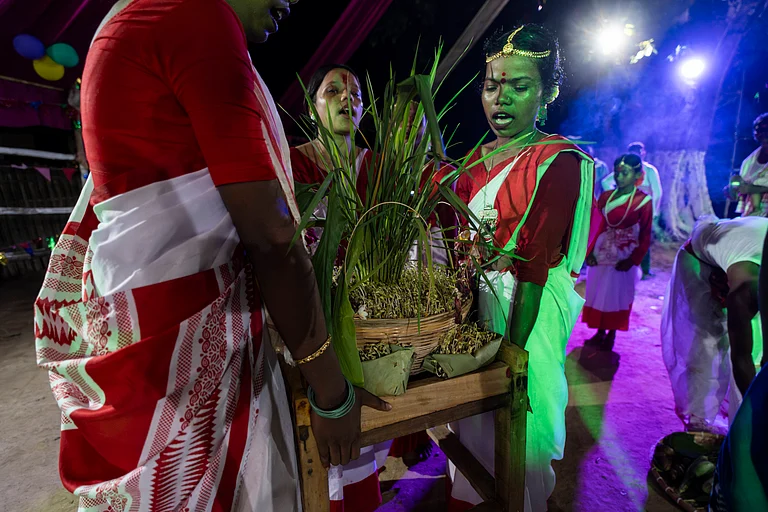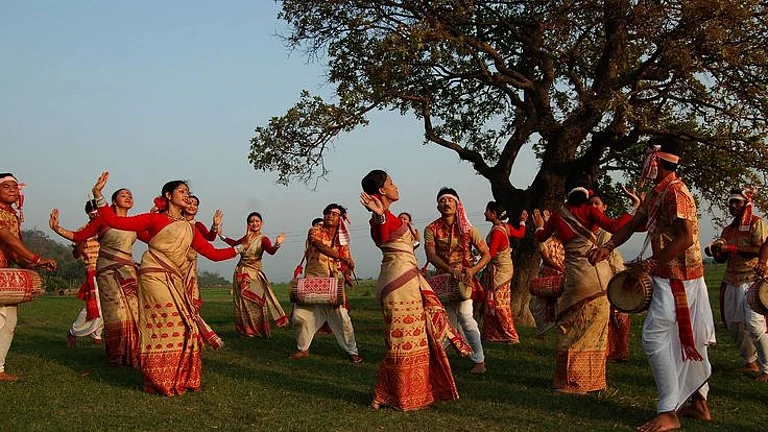The tribals in Jharkhand are campaigning to save Parasnath Hills, which they call Marang Baru — literally meaning the eldest mountain deity. The campaign is to not save it from industrial activity or government acquisition, but it’s to save it from the Jain community.
The Parasnath Hills were in the news recently over its designation as a tourist spot and the resultant protests by Jains. The Union government rolled back the decision, which pacified the Jain community, but soon the region’s tribal community —adivasis— began organising themselves over what they allege to be an encroachment of their space.
While just one hillock is sacred to Jains, where there are around 30 Jain temples, the adivasis say the entire hill range is sacred to them. Traditionally, the tribes in the region have worshipped nature, including mountains, forests, and rivers.
The tribals also allege that the Jain community has begun to dominate the region. They allege that the Jains restrict adivasi women along with Kurmi and Muslim communities in the region.
While the case of Parasnath-Marang Baru and the allegations of domination and a public movement to save ‘their’ heritage from the ‘others’ is an extreme case of contestation of a shared space, the tribals and the organised religion have a long history of interaction and contestation and assimilation have been common themes.
Indians tribes and organised religion
The Scheduled Tribes (STs) comprise 8.6 per cent of the Indian population, as per the 2011 Census. However, only 0.7 per cent and 0.2 per cent of the Indian population marked their religious affiliation as Other Religions & Persuasions (ORP) and Religion Not Stated (RNS) respectively in the 2011 Census. This suggests that the vast majority of the tribal community follows one or the other organised religion — at least officially.
Pew Research in 2021 reported that around 24 per cent of Indian Christians —around one in every four Christians— are from the STs. The adoption of Christianity by tribals is becoming a contested issue in Central India, particularly in Chhattisgarh, where Christian tribals have faced attacks recently and there is a push against religious conversions. The Hindu right-wing organisations are also active in the region which consider tribals to be a part of the Hindu fold and discourage adoption of Christianity.
While the Hindu Right considers tribals to be a Hindu constituency, tribals have long held distinct religious beliefs which are at times at odds with the organised religion. Moreover, tribes in India also follow religions other than tribal religions and Hinduism. For instance, the Gujjars in Jammu and Kashmir follow Islam and the Bhots are mainly Buddhists in upper Lahaul and the Ladakh regions.
Tribals and interactions with organised religions
Worship of nature is often central to Indian tribes. So is the belief in spirits. Contrary to the misunderstanding that tribes are primitive and simplistic, several tribes have elaborate rituals and worldviews.
For instance, the Birhor tribe is traditionally a hunter-gatherer community and their religious beliefs developed around their everyday lives. Their social organisation and religious beliefs are essentially concerned with success or luck in securing food, notes a publication of the Indira Gandhi National Open University (IGNOU).
There are spirits common to the tribe and specific to tribal clans and families comprising it. There is the supreme spirit Singbonga, symbolised by the Sun; the Burhi mai, the mother spirit also called Kali mai or Devi mai; Ora-banga or buru-banga, the spirits specific to certain hills, and haprom the ancestry spirits, among others.
While it might appear that the deities have parallels with the organised religion, there are differences between Birhors and the organised religion, such as Christianity.
“The Birhor supreme-spirit, Singh-Bonga, is creator of the world, but he does not take any active part in the direction of the universe and in the affairs of human beings. The other spirits, friendly and unfriendly, are the potential source of good luck and bad luck. But no spirit is conceptualised as God in the Christian sense of creator and ruler of the universe and the one who pronounces reward and punishment on human beings,” notes the IGNOU publication, titled Tribal Religions: Two Case Studies.
Moreover, despite some apparent parallels with Hinduism, there are ample practices to set the Birhor religion apart, such as the practice of sacrifice which is not accepted today in mainstream Hinduism.
On the other hand are the Khasis of Meghalaya, half of whom have adopted Christianity over the years despite opposition from some quarters of the community. Like Jharkhand’s tribals, the Khasis too began a movement to ‘save’ their heritage in the late 19th century. In 1899, the Khasis set up an organisation called Seng Khasi to safeguard their religion.
Jeebon Roy wrote in 1897, “The people will completely forget (their religion), with the coming of the Christian Mission, the Roman Catholic Mission, the Unitarian Mission, the Brahmo Mission; the poor religion of the Khasis without any written record will pass into oblivion and we will one day forget it completely.”
Roy’s comment is a reflection of a long-held belief that interaction or adoption of organised religion would by default lead to the dilution of the tribe’s distinct identity.
However, such concerns have not stopped the tribes from adopting religions such as Hinduism and Christianity. The IGNOU publication Religion in Tribal Societies lists several tribes that have largely adopted Hinduism: The Tharu and the Khasa tribes of Central Himalayas; Chero, Kharwar, and Pahariya of Bihar; and the Bhumij of Madhya Pradesh.
However, the same tribes can have different practices. The IGNOU publication notes that “Bhil of Rajasthan have close contacts with Muslim groups and are affected by their beliefs and practices” but Bhils in Western India also have Mahadev as a central deity and often have Brahmin priests. This shows there exists different levels of assimilation within various quarters of a community.
“By adopting Hindu caste names, wearing the sacred thread, establishing social links with the local Rajput and Brahmin groups, these tribals have incorporated their identity with high caste Hindus,” notes the IGNOU publication about Tharu and Khasa tribes.
Similarly, tribal communities have also adopted Christianity and have appropriated their customs as per Christian traditions. Some tribes that have largely adopted Christianity are Khasis, Oraon, and Bhils of Madhya Pradesh. Sarit Kumar Chaudhuri notes that several tribes in Arunachal Pradesh have largely adopted Christianity, such as Adi, Nyishi, Apatani, Galo, Tagin, Wancho, Nokte, Tangsa, and the Sulung.
Citing the case of Mundas, the IGNOU publication notes, “In some cases, traditional festivals were reinterpreted in terms of Christianised myths. For example, the origin of the festival Sarhul of the Munda was, after conversion, [was] associated by them to the fight between Alexander and King Porus in 400 BC.”
The assimilation, accommodation, and arguments involved
Verrier Elwin, advisor to former Prime Minister Pandit Jawaharlal Nehru and architect of Independent India’s tribal policy, was against both isolation and assimilation of tribals, according to Sarit Kumar Chaudhuri of Rajiv Gandhi University.
“He was a great critic of both the ‘isolation’ and ‘assimilation’ approaches. For Elwin, assimilation is equivalent to 'detribalization', and such a policy would suggest that 'animism' should be replaced by the purer ideas of Christianity and Hinduism,” says Chaudhuri in his paper The Institutionalization of Tribal Religion.
Chaudhuri quotes Elwin: “I doubt if the NEFA [North-East Frontier Agency, Arunachal's older name] people will accept Hinduism in any organised manner. Between them and that great religion stands the gentle figure of the cow...Christianity has made an appeal to the hill people of Assam (though, curiously enough, it has had very little success in Middle India and Orissa) because it has been associated in their minds with the idea of progress. Its flexibility with regard to food rules has more than compensated for its rigidity about such matters as rice beer and polygamy.”
Chaudhuri quoted scholar Koyu as writing, “The spread of Christianity adversely affected the traditional dance, music and festivals. The converts not only decline to participate in dance and music but also have abandoned most of the festivals like Solung, Etor, Aran, etc.”
In such a backdrop, a movement emerged in the region to institutionalise the religion of Adi and Galo tribes, called the Donyi-Poloism movement. The founder of the movement, Talom Rukbo, “felt that many such tribal traditions are fading out, and institutionalization is the only way to preserve these traditions”, as per Chaudhuri.
The institutionalisation involved making myths about their religion, establishing sacred places with idols, creating sacred images, and collection, compilation, and fresh composition of religious literature, including songs and prayers. The Donyi-Poloism movement was followed by Nyedar Namlo movement among the Nyishis and Danyi-Piilo among the Apatani tribes.
In doing so, these communities accommodated elements of Hinduism and resultant institutionalised religious images were Hinduised to some extent.
Chaudhuri notes, “All these movements received immediate patronage overtly or covertly from the Hindu nationalist organizations who are trying to create a strong base in this frontier state.
“Many of the images invented are largely Hinduized idols, though an attempt has been made to assimilate some local traits into such images based on their mythical characters. Moreover, in the name of reviving indigenous tribal religion, the way it was institutionalized also reveals or supplements how Hinduized norms were imposed consciously or in disguised ways.”
Chaudhuri’s study is an example of how tribals have had to accommodate organised religion —Hinduism in case of Arunachal’s tribes— in order to prevent outright assimilation and dilutions of their traditions.
Issues with Hinduism and tribal accommodation
It is often also highlighted that several practices, such as considering the rivers, mountains, and trees holy, are common in Hinduism and tribal faiths. However, Virginius Xaxa notes, “To categorise tribes as Hindus in India therefore smacks of cultural and religious expansionism. Just because there are some similarities, tribals cannot be denied their distinct identity and autonomy. It is important to note that religion does not only include practices. It also includes ideas and beliefs. However this is completely glossed over even by the sociologists and social anthropologists in their discussion and analysis of tribal religion.”
In his paper Transformation of Tribes in India: Terms of Discourse, Xaxa notes that even when tribes gets Hinduised, they retain a distinct identity and are often out of the Hindu caste structure.
He notes, “In fact, even after Hinduisation tribes remain by and large outside the hierarchical structure of Hindu society. If at all tribes have made claims they have been made only after they have been drawn into the larger social structure of the neighbouring Hindu and linguistic community…Theoretically it is possible to embrace a form of Hindu faith and practices without becoming part of Hindu society in the caste sense.”
With the inroads of Christianity in Central Indian tribes, the Hindu Right is working zealously to bring the tribes into the Hindu fold. To do this, the organisations are carrying out drives to familiarise the tribals with Hindu texts like Ramayana and Mahabharata and how the tribals were central to the narratives, as per reports.
While the Hindu Right often considers tribals as part of the Hindu fold, scholars have highlighted several issues with the approach. There are several divergences between the tribals and the organised Hindu religion. To cite one example, in an article for Outlook, Dr Pragya Shukla noted that Asuras of Central India consider Mahishasur their ancestor, which is a demon killed by a Hindu Goddess in mainstream Hinduism.
Shukla notes, “The Asurs consider Mahishasur, Lohasur (master smelter), and Ravana to be their ancestors. Distraught by the evil portrayal of Mahishasur by the upper castes, the Asurs claim that Mahishasur was a just, liberal king, a valiant protector of all his subjects. Their king it is believed was deceitfully killed by Durga.
“Mahishasur, according to them has been wrongly portrayed as an evil character. Hence, while one section of the society rejoices in the festivities of Navratri, the Asurs mourn the death of their king.”


























